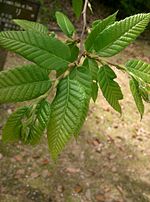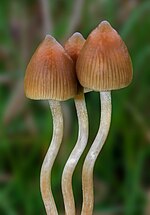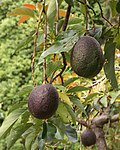Phytophthora cinnamomi, also known as cinnamon fungus, is a soil-borne water mould that produces an infection which causes a condition in plants variously...
20 KB (2,029 words) - 18:14, 13 August 2024
dicotyledons, and many are relatively host-specific parasites. Phytophthora cinnamomi, though, infects thousands of species ranging from club mosses,...
30 KB (2,372 words) - 08:03, 5 June 2024
native to Japan and Korea. Castanea crenata exhibits resistance to Phytophthora cinnamomi, the fungal pathogen that causes ink disease in several Castanea...
5 KB (519 words) - 19:11, 29 September 2024
Nightcap National Park (section Phytophthora cinnamomi)
by Phytophthora cinnamomi. NSW Department of Environment and Climate Change. 2008. Hardham, A.R. (2005). "Pathogen profile: Phytophthora cinnamomi". Molecular...
36 KB (3,828 words) - 17:46, 25 July 2024
Root rot (redirect from Phytophthora root rot)
necatrix Scytinostroma galactinum aka Corticium galactinum Phytophthora – see Phytophthora cinnamomi for discussion on treatment Basidiomycete fungi are wide-spread...
5 KB (685 words) - 04:41, 12 August 2024
resistance to Phytophthora cinnamomi, the fungal pathogen that causes ink disease. The mechanism of resistance of C. crenata to Phytophthora cinnamomi may derive...
90 KB (10,102 words) - 19:52, 3 September 2024
fungi Phytophthora cinnamomi and Phytophthora ramorum, which have caused severe, red-black cankers in the trunk region of the species. Both P. cinnamomi and...
28 KB (3,457 words) - 02:22, 27 July 2024
McCracken AR (1991). "Microbial suppression of Phytophthora cinnamomi". In Lucas, John (ed.). Phytophthora: Symposium of the British Mycological Society...
55 KB (5,896 words) - 20:34, 5 August 2024
November 2005, wild-growing trees were found to be infected with Phytophthora cinnamomi. New South Wales park rangers believe the virulent water mould was...
37 KB (3,633 words) - 20:27, 17 September 2024
it appears to have some resistance to the soil-borne water mould Phytophthora cinnamomi. A bushy shrub, Banksia aculeata grows up to 2 m (7 ft) tall, with...
19 KB (2,206 words) - 00:47, 2 December 2023
the local habitat. The species is susceptible to the impact of Phytophthora cinnamomi, a soil borne fungal-like species that is associated with forest...
30 KB (3,594 words) - 17:43, 19 August 2024
remains relatively unmolested by pests and diseases in Romania, with Phytophthora cinnamomi, Monilinia vaccinii-corymbosi, Botryosphaeria corticis, Godronia...
51 KB (4,808 words) - 02:43, 24 September 2024
trees dry out and wither away. It is caused by Phytophthora cambivora and Phytophthora cinnamomi. Phytophthora disease is the longest-known chestnut tree...
91 KB (10,699 words) - 22:15, 22 September 2024
Kauri dieback (redirect from Phytophthora agathidicida)
heveae. Phytophthora in mainland New Zealand kauri trees was also identified causing dieback in the Waitakeres linked to Phytophthora cinnamomi. In March...
40 KB (3,219 words) - 22:56, 9 July 2024
be subject to Phytophthora root rot in moist, hot conditions. Azaleas share the economically important disease Phytophthora cinnamomi with more than...
13 KB (1,265 words) - 21:24, 8 September 2024
have been recent reports of Phytophthora cinnamomi affecting deodar cedars in the Himalayan regions. Phytophthora cinnamomi has killed 200 trees so far...
6 KB (637 words) - 10:44, 23 March 2023
European chestnut trees (Castanea sativa). Ink disease, also caused by Phytophthora cinnamomi, is thought to have been present in Europe since the 18th century...
7 KB (629 words) - 20:23, 27 December 2023
adaptation leaves them highly vulnerable to dieback caused by the Phytophthora cinnamomi water mould, and generally intolerant of fertilization. Due to these...
36 KB (4,144 words) - 01:24, 24 September 2024
Ranges caused by Phytophthora cinnamomi in the 1950s, again on Great Barrier Island in 1972 linked to a different pathogen, Phytophthora agathidicida and...
42 KB (5,456 words) - 20:06, 25 June 2024
aeration or resistance to the soil-borne disease (root rot) caused by Phytophthora cinnamomi. Advances in cloning techniques that can produce up to 500 new plants...
82 KB (8,643 words) - 08:46, 26 August 2024
conservation groups. Another threat to Banksia is the water mould Phytophthora cinnamomi, commonly known as "dieback". Dieback attacks the roots of plants...
47 KB (5,259 words) - 11:37, 13 September 2024
pests such as Colletotrichum gloeosporioides, Diplodia species and Phytophthora cinnamomi (stripe canker) can affect the growing plants. The stems must be...
48 KB (5,313 words) - 14:34, 5 September 2024
(Platypus cylindrus), a species of weevil. The common water mould Phytophthora cinnamomi grows in the roots of the tree and has been known to devastate cork...
32 KB (3,831 words) - 12:30, 23 September 2024
2018 in Northern Territory and Western Australia. The Oomycete Phytophthora cinnamomi, commonly known as wildflower dieback or jarrah blight, has created...
53 KB (4,757 words) - 05:13, 28 September 2024
responses of native Australian plant species to Phytophthora cinnamomi" (PDF). Management of Phytophthora cinnamomi for Biodiversity Conservation in Australia...
48 KB (5,603 words) - 12:30, 15 September 2024
pathology Witch's broom White Pine Blister Rust Phytophthora cinnamomi, which causes root rot Phytophthora ramorum, which causes sudden oak death Polypore...
9 KB (1,063 words) - 07:41, 10 May 2024
through purely natural means. Infestation with the fungal pathogen Phytophthora cinnamomi has been recorded in other plant species around 20 metres (66 ft)...
16 KB (1,740 words) - 03:44, 6 July 2024
foliage. It is extremely sensitive to dieback from the pathogen Phytophthora cinnamomi Isopogon ceratophyllus is a prickly shrub, growing to 15–100 cm...
8 KB (737 words) - 00:40, 7 May 2023
that elevated levels may be associated with deadly infections by Phytophthora cinnamomi. Sustainable fertilisation practices, including soil testing and...
20 KB (2,005 words) - 19:34, 8 July 2024
known pests, but it is subject to root-rot and crown-rot caused by Phytophthora cinnamomi and does not endure drought well. It is commercially available for...
20 KB (2,259 words) - 10:13, 17 July 2024


























